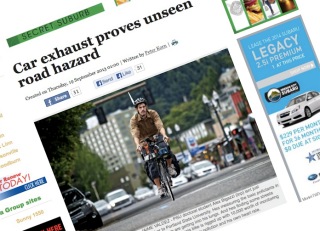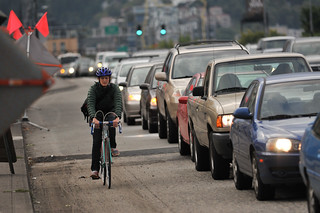The Portland Tribune published an article yesterday with a scary headline: “Car exhaust proves unseen road hazard.” The story chronicled the efforts of transportation researcher Alex Bigazzi, who rides around Portland with special equipment attached to his bike in order to measure air quality.
Bigazzi is a doctoral student at Portland State University who’s no stranger to this topic. In 2010, we wrote about research he worked on that pointed to the air quality and health benefits of streets that have cycle paths separated from auto traffic. Bigazzi’s latest work, as highlighted in the Tribune, are sure to raise some eyebrows. Here’s one of the opening paragraphs:
You might want to stay off Southeast Powell Boulevard if you’re a bike rider — Bigazzi’s breakthrough data shows biking on Powell leaves a rider with two to three times more volatile organic compounds in their lungs as a ride on a less-trafficked neighborhood bikeway route such as Southeast Clinton or Lincoln streets.
This concept isn’t new. In 2011, we shared a bit of research from Canada that showed how cycling in heavy traffic could have a “significant impact” on heart health due to exposure to air pollution.

While the quality of the air we breathe is obviously an issue everyone cares about, the framing of the article in the Tribune has sparked a separated (yet related) debate: Is poor air quality on arterials a good reason for people to stop riding on them? Many people (including PBOT to some degree) strongly advocate that bicycle users should always use side streets when moving around town. On the other hand, other people resist that suggestion because they are comfortable riding on arterials (like Sandy for instance) and enjoy the convenience and access to destinations they provide.
The Tribune article spurred local citizen activist Doug Klotz to write on a local email list, “I suspect this was intended to be, and will be, used against any call for bike facilities on major streets.”
Bigazzi himself has also chimed in on the email thread. “My research does not address where the city should invest in bike infrastructure, or how road space should be allocated to reduce exposure for everyone,” he wrote. “If someone wanted to use my results to argue against providing space for bikes on arterials, they would have to consider how different bicycle infrastructure affects bicycle travel, auto travel volumes, and traffic patterns – which is a whole other area of research.”
Bigazzi continued: “That said, if you are a traveler, and trying to avoid air pollution, these results can provide information to help inform route choice decisions within the constraints of existing conditions.”
Another thing to consider when thinking about biking and auto exhaust is that air filters in cars don’t block pollutants. The reason this is a bigger deal for bicycle operators is that they breath harder than auto users and therefore the “intake and uptake rates of the pollutants are higher,” Bigazzi writes.
And of course, while the Tribune story goes into detail about the terrible things the toxic exhaust from cars can do to your body, it doesn’t mention the myriad health benefits of using a human-powered vehicle. When weighed against pollution intake, the physical benefits of riding outweigh the negative impacts of bad air quality.
Our reaction to this story and research shouldn’t be, “Bicycle riders should stay off arterials!”. It should be, why do we have streets where road users are forced to operate their vehicles mere feet from other vehicles that are spewing toxic chemicals into the air? Given that Transportation Commissioner Steve Novick is such an advocate of public health and bicycling, it appears he could use this research as yet another strong argument for doing more road diet projects, implementing more policies to discourage auto use in the central city, and building more cycle tracks separated from auto traffic on major streets.
In the meantime, we’re still holding our breath.
Read more about Alex Bigazzi’s research and his rolling bike laboratory at PortlandTribune.com.


